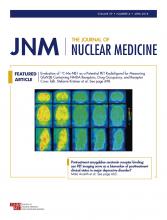TO THE EDITOR: Recently, we have read with interest the paper by Mayer et al. published in The Journal of Nuclear Medicine (1). The authors assessed the effects of 6 immuno-PET radiotracers on human programmed cell death ligand 1 (PD-L1) immune checkpoint imaging and discussed important design considerations that may affect biodistribution of radiotracers. Those radiotracers were specifically against human PD-L1 but did not cross-react with murine PD-L1. As we inferred, clinical immuno-PET tracers can bind not only to PD-L1 expressed by tumors, but also to PD-L1 expressed by normal cells. It is known that PD-L1 is expressed wildly on T cells, B cells, monocytes, and endothelial cells in both humans and mice (2). Therefore, radiotracer can be taken up by PD-L1–positive cells in organs, including lymphoid organs, lung, and liver, resulting in unexpected background signal and confounding determination of PD-L1 level in tumors. To optimize the immuno-PET imaging effect, especially in terms of background signal, we suggest using antimurine radiotracers and murine tumor cell lines for syngeneic tumor engraftments, because these will better fit the putative clinical status, rather than performing in vivo study in human tumor xenografts.
We are also concerned about the inherent characteristic of PD-L1 after immuno-PET imaging. It is known that radiotracers can induce cell internalization; thus, the targeted receptor could be involved and relocated from membrane to cytoplasm (3,4). During immuno-PET imaging, PD-L1 is internalized but the metabolic mechanism is unclear, partially including degradation and repopulation back to the tumor cell surface. Moreover, whether the affinity between PD-L1 and tracer would change after being detected by immuno-PET for the first evaluation and monitoring assessment during treatment remains unknown. To identify the potential affinity change, we suggest conducting another immuno-PET scan or surface plasmon resonance after the radiotracer is entirely eliminated.
Additionally, it is possible that the expression level of PD-L1 may not be a favorable biomarker for predicting anti–PD-L1 response. By analyzing the outcome of patients with different PD-L1 level, Robert et al. reported no difference in overall survival between the high-expression PD-L1 group and low or negative group after immunotherapy with anti–PD-L1 antibody (5). Therefore, high uptake of radiotracer at a tumor site may not predict a good response whereas low uptake may not indicate a poor response. To better predict anti–PD-L1 response, a combination of PD-L1 status and other cancer genetic biomarkers should be further considered (6).
Generally, immuno-PET imaging represents a novel imaging procedure and is helpful for selecting optimal patients and monitoring the expression status of specific molecules during anti–PD-L1 treatment. It could become the go-to complement to immunotherapy in the near future.
Footnotes
Published online Nov. 16, 2017.
- © 2018 by the Society of Nuclear Medicine and Molecular Imaging.







